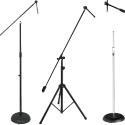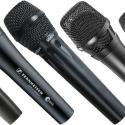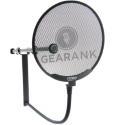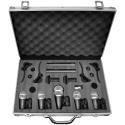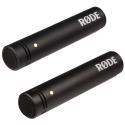Everything You Need To Know About Different Mic Stands
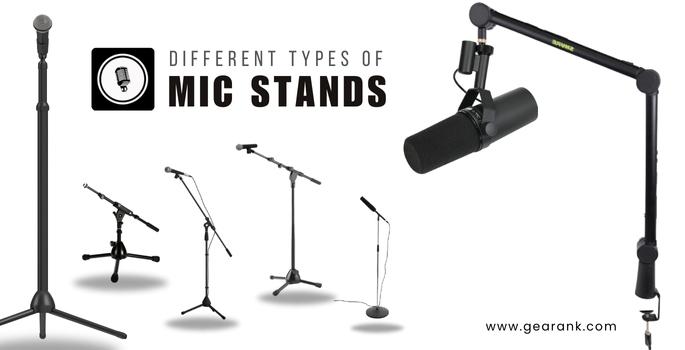
Picture this: You brought all the necessary equipment, from the condenser and cables to your audio interface. You and your friend are excited to record your voice and acoustic guitar.
But as you are setting up, it dawned on you that you forgot to bring mic stands.
Indeed, holding a mic isn't a gargantuan task. But imagine cupping a condenser mic with your hands when recording. Imagine live performances with no mic stands around to let your hands rest when performing live. Without mic stands, basic things such as recording vocals and live performances will be a pain to do.
Different mic stand types offer convenience and an easier way to record music. However, despite their importance, some people don't consider how valuable a good stand can be.
Do you know there are different types of mic stands? They can vary for live performances, podcasts, and recordings. Maybe using a different mic stand with extra features can make your setup more convenient.
Thus, in this article, we will walk you through different mic stands and various accessories you can use to maximize your options.
What Is A Microphone Stand?
The main purpose of a mic stand is to hold a microphone. Mic stands offer a hands-free option when performing live with an instrument or recording.
Microphone stands have been around for 130 years. Up to this day, nobody knows who invented the mic stand because, just like a chair, it's built out of pure utility to hold a mic in place.
Aesthetically speaking, famous artists like Steven Tyler and Brendon Urie have been known for customizing their mic stands.
Functionally speaking, there's so much more to mic stands other than keeping it stable.
Why Are Microphone Stands Important?
Convenience, more freedom, and a sturdy medium to perform or record is one thing. However, mic stands also play a role when it comes to sound quality, such as:
-
Positioning the mic to an amp.
-
Angling overhead mic stands for recording a drum kit.
-
Hands-free option for recording setup to avoid bumps, rustling, and contact noises.
-
For adjusting the distance in podcasts.
The Different Types Of Mic Stands
Different types of mic stands will offer several benefits depending on utility. I've detailed the most common and popular types below.
Tripod Microphone Stand
Tripod stands are one of the most popular, if not the most popular, type of stand everyone uses. The tripod stand usually falls into the "standard stand" category.
They tend to feature one vertical pole that holds a mount or mic clip at the top. The height of a tripod mic can be easily adjusted to suit different individuals.
Like most straight mic stands, the tripod stand has a solid base with three legs, each with rubber feet. Relatively affordable, this type of stand is known for being easy to use and fold away.
The downside to this type of stand is that the vertical pole stands too close to the performer, leaving little room for instruments.
Tripod Boom Microphone Stand
This is a variation of the tripod mic stand. The tripod boom stand features the same three legs but has either a fixed or an extendable boom arm.
Also known by the name boom mic stands, They're applicable for both live performances and studio recordings.
A boom arm is a pole that goes through the clamp and is attached to the top of a stand. This provides the stand with more flexibility and comfort.
More importantly, it allows for more space between the performer and the vertical pole, allowing vocalists to comfortably sing while playing guitars and other instruments.
In addition to vocals, boom stands are widely used in miking guitar amps and as an alternative for overhead mic stands.
A boom mic also has a lower risk of any trips, as you won't need to stand as close.
Round Base Microphone Stand
A round base mic stand type is another common variation. It's usually made out of die-cast metal. Round base stands have a circular, weighted base, giving anyone enough stability whilst still being able to move it around to perform.
A typical round base stand will consist of a straight pole with a mount at the top and a circular weighted base. Most vocalists prefer to use round bases when performing because they are harder to trip over.
Overhead Microphone Stand
Sometimes confused with the tripod boom microphone stand, overhead microphone stands typically have a more resilient and robust construction designed to accommodate drum overhead mics. They're on the pricier side of mic stand types, but well worth the money.
The base of an overhead stand usually features a solid, steel, triangular base with several legs. Some of these overhead mic stands come with lockable wheels to facilitate ease of use. Adjustments in position are much easier if you can roll and lock them in place.
This type of mic stand is most commonly used in music recording studios because it is better equipped for picking up the room ambiance.
Low-Profile Microphone Stand
Also known as short mic stands, low-profile mic stands are essentially mini versions of the classic tripod boom arm.
Low-profile mic stands are normally used to record sounds and audio closer to the floor. It doesn't occupy that much space compared to a tripod boom stand and is easier to use when getting the right angle for recording kick drums and guitar cabs.
Desktop Microphone Stand
Desktop mic stands or desk mounts are used to record audio while sitting at a desk. They are regularly used in music studios but most commonly found in Podcast Studios and live-stream shows.
Aside from their small stature, they look and perform the same as a tripod or round base stand.
Different Types Of Mic Stand Setups/Accessories
Microphone stands can be set up in several ways, using different pieces of equipment and optional accessories. I'm going to show you some of the most popular mic stand setups and accessories we can use.
Pop Filter
Pop filters are placed between the mics and the vocalist. When in position, a pop filter will prevent any excessive plosive or popping sounds from the speech or singing microphone. This accessory is vital if you want to produce clear and crisp audio.
Also referred to as a pop shield, a pop filter can be attached to a boom arm stand.
Mic Boom Arm
Not all stands come with a mic boom arm. Therefore, booms can be a good piece of equipment to add to your stock mic stand setup.
Like with the tripod boom stand, we can use boom stands to give ourselves a greater range of movement. Boom arms are attached to the straight stand, and the microphone is then attached to the boom arm via a mic clip.
The size and shape of boom stands can vary widely. And there is a seller for all sorts of booms, telescoping boom arm, desk boom arm, podcast boom arm, and so on.
Shock Mount
A shock mount is used to hold condenser microphones in place. They are specifically designed to reduce low-frequency vibrations and thumps. These shock absorbers take any little movement from the condenser, giving you a clear audio free from bumping or shaking sound.
Smartphone or Tablet Mount
Using a tablet mount stand, you can position your devices in a way that makes it easier for you to perform and record. This is much easier than trying to read your device from a desk or with your hand.
This is especially useful in VO or live band situations where the talent or the singer doesn't have to hold a smartphone or a tablet. I personally request this from the venues, or bring mine along when performing.
Headphone Rack
When recording in a music studio, a headphone rack can come in handy for those times you need a break. Instead of putting your headphones away, you can simply place them on a convenient headphone rack on your stand.
Most musicians use a headphone rack in the studio to keep everything organized.
Things to Look For In A Mic Stand Types
While everyone's needs and requirements vary, most people will look for the same things when trying to find the best mic stand.
To finish off, I've listed some of the most common and important things most people look for when looking for the best stand. Mic stands might look identical from brand to brand, but there are some things you have to take into consideration when purchasing one.
1. Durability
In church or gig setups, microphone stands you need something that "stands" the test of time. Commonly, cheaper ones will work excellent initially then wear out over time. Screws going loose, boom arms gradually sagging out of nowhere, or worse, the pole slipping down in the middle of a good recording session. A good mic stand should be able to carry a decent amount of weight. Choose a microphone stand with great value, durable steel, and robust moving parts.
2. Versatility
Is the mic stand adjustable? Does it have telescoping parts where you can extend or shorten the boom for certain applications? Is it foldable enough that you can store it in a small space? Before purchasing, test out if the moving parts are working as intended.
3. Stability
As I've said, a good mic stand should be able to handle enough weight. A solid stand should have a center of gravity that doesn't topple over at the slightest movement. Moreover, the mic stand that you choose should also fit your current situation. For instance, using a round base stand is preferable over tripod stands when using the best live vocals mic on stage to avoid tripping hazards. On the other hand, tripod stands are better when recording vocals to create distance from the base of the stand to the vocals.
4. Professional Look
Functionality aside, you want to have a microphone stand that looks sleek and well-built. Plenty of brands out there, like the ones from Gator Frameworks and K&M, are some of the brands I’d highly recommend.
Final Thoughts
And there you have it. Behind every good performer and recording are mic stand types that hold your microphones and other gear in place.
Use this as a guideline or reference. We’ve gone through different types of stands, different setups, and accessories.
I’ve also given you some tips on what to look for when purchasing your first mic stands.
If you're looking to buy a mic stand from top seller brands like Samson, Ultimate Support, and more, see our top mic stand recommendations.
Contributors:
- Allen Articulo - Co-writer
- Jerry Borillo - Illustrator



